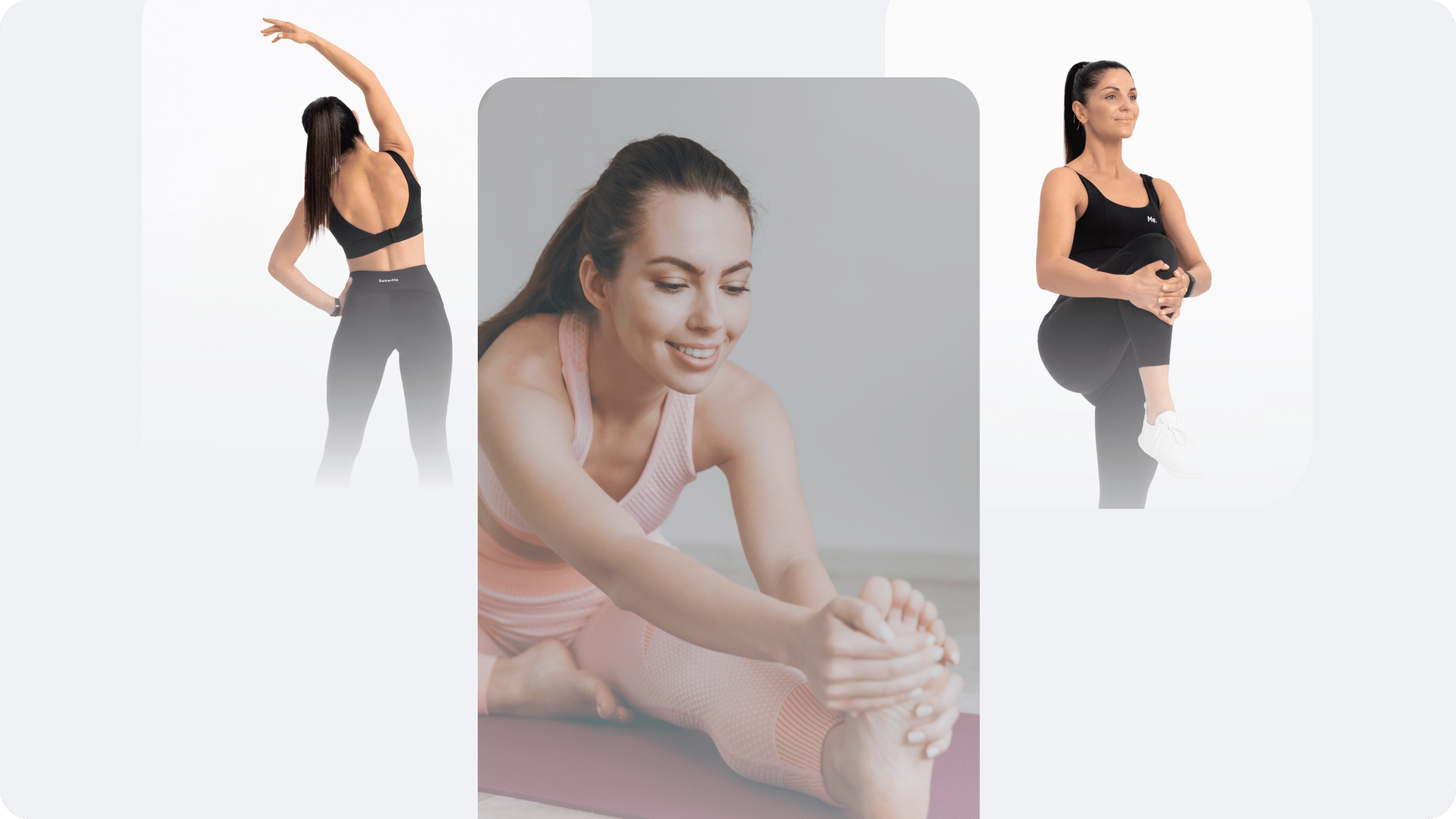If you’ve been exploring ways to elevate your physical and mental health, you may have encountered somatic exercises and wondered what they’re all about. Let’s explore the fascinating world of somatics and discover how they can help you feel better in both body and mind.
The word “somatic” comes from the Greek word “soma”, which means “body”. So, when we talk about somatic exercises, we’re focusing on the body’s internal sensations and experiences, as opposed to emotional dimensions such as thoughts and feelings (13). In our journey to achieve holistic health benefits in life, somatic exercises have emerged as a game-changer.
Unlike traditional exercises that focus on intensity and external results, somatic exercises focus on improving the mind-body connection, creating a deeper awareness of internal sensations to improve overall well-being. In brief, somatic exercises are all about being aware of how your body feels and moves. But why is this emphasis on the mind-body connection so important?
Before we delve into that, let’s talk about one of the key figures in the somatic movement, Thomas Hanna. Back in the 1970s, Hanna coined the term “somatics” and introduced the world to it (8). As a philosopher and movement educator, he delved deep into understanding the intricate relationship between the body and mind. Through his techniques, Hanna aimed to help individuals release chronic muscle tension and enhance movement through gentle, mindful exercises.
You may be familiar with “The Body Keeps the Score” by Dr. Bessel van der Kolk (1). He explains how the body retains memories of experiencing traumatic events and highlights its role as a means of communication with yourself and others. He further illustrated how trauma can become lodged within the body, leading to persistent pain and various challenges.
Stress is something we all experience and our bodies are designed to respond to it. When we face a threat, our bodies release hormones such as cortisol and adrenaline to prepare us to deal with it – this is known as the “fight or flight” response (16). While it’s helpful in short bursts, long-term stress can lead to problems such as anxiety, depression, and chronic pain and have an impact on every system in the body (19).
Now, let’s get back to the previous question – why is this emphasis on the mind-body connection so important? The profound connection between the mind and body lies at the core of somatic exercises. We now know that emotions linked to traumatic memories and stress can be stored in our bodies and manifest as physical tension.
The mind and body are deeply connected, and this relationship is at the heart of somatic exercises. Somatic exercises can enhance proprioception (the body’s ability to sense its position and movements in space) and interoception (the perception of internal bodily sensations), which are essential components of body awareness.
By cultivating a deeper awareness of this interconnectedness, somatic exercises empower us to address both our mental and physical well-being simultaneously.
What Are the Benefits of Somatic Training?
Physical Benefits
- Improved Mobility and Flexibility
Imagine moving with the fluid grace of a dancer. Somatic exercises help increase your range of motion and flexibility by gently stretching and mobilizing muscles and joints. The slow, deliberate movements release chronic tension and stiffness, which leads to improved mobility and a more youthful, agile body.
- Enhanced Posture and Alignment
Standing tall isn’t just about confidence, it’s about health. By increasing body awareness, somatic exercises can correct postural imbalances and promote proper alignment (7). This enhances your physical appearance and reduces the risk of developing musculoskeletal issues such as back and neck pain.
- Pain Relief
Are you tired of living with chronic pain? Somatic exercises may be the solution you’ve been looking for. These practices target the root causes of pain by retraining your nervous system to adopt healthier movement patterns (9). Whether it’s lower back pain, sciatica, or fibromyalgia, somatic exercises can provide significant relief and improve your quality of life.
- Increased Strength and Stability
Strength isn’t just about lifting heavy weights. Somatic exercises build core strength and stability through controlled, mindful movements that engage deep stabilizing muscles (15). This foundation of strength helps maintain balance, prevent injuries, and support all your daily activities.
Running a never-ending rat race, shoving trauma further and further away, falling into self-harming thought patterns, living life that’s eclipsed by constant anxiety and fear – this is what an average person goes through every day. Not addressing it will only pull you deeper into a downward spiral. BetterMe: Meditation & Sleep app will help you gain a new perspective on life and help you regain that long-lost internal balance!
Mental and Emotional Benefits
- Stress Reduction
Stress (19) is the ultimate body tension-maker. Stress is a common companion in the modern fast-paced world. Somatic exercises promote relaxation and reduce stress by calming the nervous system through a process known as somatic stress release. This approach focuses on breath and body sensations, helping release stored tension and trauma.
By bringing you into the present moment, somatic stress release creates a state of mental tranquillity and peace, which allows your body and mind to reset and recover from the effects of chronic stress.
- Improved Mind-Body Connection
How often do you listen to your body? Somatic exercises create a deeper connection between the mind and body, which enhances self-awareness. This heightened awareness can lead to better self-care practices and a more profound understanding of your physical and emotional needs.
- Enhanced Mental Clarity and Focus
Mental fog, be gone! The mindfulness component of somatic practices sharpens mental clarity and focus. By practicing present-moment awareness, you can improve your concentration and cognitive function, which will benefit both your personal and professional life (17).
- Emotional Release
As previously mentioned, emotions can get trapped in the body as physical tension. Somatic exercises provide a safe space for releasing these pent-up emotions, which leads to emotional healing and improved mental health. This release can help you manage symptoms of trauma, anxiety, and depression, paving the way for a happier, more balanced life (11).
Do Somatic Exercises Really Work?
Are somatic exercises truly effective? This is a question many individuals ask when they’re considering integrating somatic practices into their wellness routines. Somatic exercises are rooted in the principles of mindful movement and body awareness and have gained popularity for their purported benefits in enhancing physical and mental well-being. But do they deliver on their promises?
Several well-known somatic movement practices, including the Feldenkrais Method, Alexander Technique, and Laban Movement Analysis, employ specific techniques and principles to enhance body awareness and facilitate positive changes in movement patterns and posture.
But what do studies say about the effectiveness of somatic exercises? While research on somatic practices is still evolving, preliminary evidence suggests promising outcomes. Studies have demonstrated improvements in various areas, including pain management, stress reduction, and functional movement (5, 12 ).
Somatic exercises such as breathwork have been found to improve mood and reduce the symptoms of stress, depression, and anxiety (3, 6, 2). While more research is needed to fully understand the mechanisms and long-term benefits of somatic exercises, existing evidence and anecdotal accounts suggest that they can be effective in the promotion of physical and mental well-being.
Whether you’re looking to alleviate chronic pain, reduce stress, or enhance body awareness, somatic exercises have the potential to support your journey toward optimal health and vitality.
Read more: Somatic Healing Techniques: A Holistic Approach to Physical and Emotional Recovery
When Should You Do Somatic Exercises?
The beauty of somatic exercises lies in their flexibility and adaptability, which makes them suitable for various times and circumstances. Here are some key moments when it can be particularly beneficial to incorporate somatic exercises into your routine:
Morning Routine
Starting your day with somatic exercises can help awaken your body and mind, setting a positive tone for the day ahead. Gentle movements and mindful awareness can prepare your muscles and joints for the activities to come, promoting a sense of readiness and calm.
During Breaks
Incorporating somatic exercises into your breaks, particularly if you have a sedentary job, can counteract the stiffness and tension that build up from prolonged sitting. A few minutes of mindful movement can refresh your body and mind, boosting productivity and reducing stress.
Try this simple grounding exercise: Move away from your desk and stand tall. Close your eyes if you’re comfortable or soften your gaze. Take a moment to feel the connection between your feet and the ground. Notice the sensations of your feet firmly placed on the ground. Take a moment to notice these sensations without any judgment. Take a deep breath in and slowly open your eyes.
Post-Workout
After a traditional workout, somatic exercises can serve as an excellent cool-down routine. They help relax your muscles, improve flexibility, and integrate the benefits of your workout by bringing attention to how your body feels and moves.
Before Bed
Engaging in somatic exercises before bed can be a wonderful way to wind down and promote restful sleep. The gentle, mindful movements help release the day’s accumulated tension, calm your nervous system, and prepare your body for relaxation and recovery.
When You Feel Overwhelmed or Stressed
Whenever you feel stressed or anxious, taking a few moments to practice somatic exercises can provide immediate relief. By focusing on your breath and bodily sensations, you can shift your attention away from stressors and bring yourself back to the present moment, fostering a sense of calm and grounding.
In essence, there is no single “right” time to do somatic exercises. The best time is whenever you feel the need to reconnect with your body and mind. The versatility and gentle nature of these practices make them an accessible and beneficial addition to any routine, supporting your overall health and well-being at any time of day.
BetterMe: Meditation & Sleep app can help you transmute stress into serenity, pull you up from the doldrums, free your mind from the cares and worries of the world, quell racing thoughts and infuse you with tranquility! Start using it now and change your life!
Does Somatic Therapy Really Work?
Various forms of therapies integrate body-focused approaches of somatic therapy, such as Eye Movement Desensitization and Reprocessing (EMDR), Somatic Experiencing Therapy, Accelerated Experiential Dynamic Psychotherapy (AEDP), and Sensorimotor Psychotherapy, offering unique methods to help individuals process and heal from trauma (4, 18, 14).
Research and clinical practice suggest that somatic therapies can be highly effective, particularly for those with trauma-related conditions. By addressing the physical manifestations of psychological issues, these therapies offer a holistic approach that can lead to profound and lasting healing.
DISCLAIMER:
This article is intended for general informational purposes only and does not serve to address individual circumstances. It is not a substitute for professional advice or help and should not be relied on for making any kind of decision-making. Any action taken as a direct or indirect result of the information in this article is entirely at your own risk and is your sole responsibility.
BetterMe, its content staff, and its medical advisors accept no responsibility for inaccuracies, errors, misstatements, inconsistencies, or omissions and specifically disclaim any liability, loss or risk, personal, professional or otherwise, which may be incurred as a consequence, directly or indirectly, of the use and/or application of any content.
You should always seek the advice of your physician or other qualified health provider with any questions you may have regarding a medical condition or your specific situation. Never disregard professional medical advice or delay seeking it because of BetterMe content. If you suspect or think you may have a medical emergency, call your doctor.
SOURCES:
- Book Review: The Body Keeps the Score: Brain, Mind, and Body in the Healing of Trauma (2021, ncbi.nlm.nih.gov)
- Brief structured respiration practices enhance mood and reduce physiological arousal (2023, ncbi.nlm.nih.gov)
- Effect of breathwork on stress and mental health: A meta-analysis of randomised-controlled trials (2023, nature.com)
- EMDR beyond PTSD: A Systematic Literature Review (2017, frontiersin.org)
- Evidence for the effectiveness of Alexander Technique lessons in medical and health-related conditions: a systematic review (2012, pubmed.ncbi.nlm.nih.gov)
- How Breath-Control Can Change Your Life: A Systematic Review on Psycho-Physiological Correlates of Slow Breathing (2018, ncbi.nlm.nih.gov)
- Improving Posture and Alignment Through Somatics (2022, liebertpub.com)
- Living in Movement: Development of Somatic Practices in Different Cultures (2011, tandfonline.com)
- Moving With Pain: What Principles From Somatic Practices Can Offer to People Living With Chronic Pain (2021, frontiersin.org)
- Pilates, Mindfulness and Somatic Education (2014, ncbi.nlm.nih.gov)
- Practical applications of grounding to support health (2023, sciencedirect.com)
- Randomized controlled trial of the Alexander Technique for idiopathic Parkinson’s disease (2002, journals.sagepub.com)
- Somatic (2018, dictionary.apa.org)
- Somatic experiencing – effectiveness and key factors of a body-oriented trauma therapy: a scoping literature review (2021, tandfonline.com)
- Somatic Strength Training: An Alternative to “No Pain No Gain” (2020, liebertpub.com)
- Stress effects on the body (2023, apa.org)
- The Dancing Brain: Attention, Cognition, and Somatic Movement (2021, liebertpub.com)
- The Merits of Integrating Accelerated Experiential Dynamic Psychotherapy and Cultural Competence Strategies in the Treatment of Relational Trauma: The Case of “Rosa” (2018, pcsp.libraries.rutgers.edu)
- What Does Stress Do to the Body? (2022, webmd.com)










